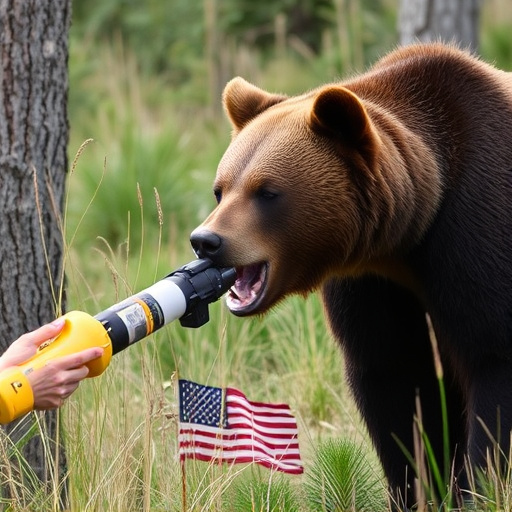Understanding bear behavior and wind direction is key for backcountry safety, especially when using bear deterrent spray like GrizGuard. Bears have a powerful sense of smell, so knowing the wind direction prevents blowing your scent towards them unexpectedly. Bear spray should be used cautiously as close encounters are rare; precautions include noise-making, avoiding known habitats during specific seasons, and securing food in bear-resistant containers. When using spray, prioritize Wind Direction Bear Spray Safety by ensuring the wind blows away from you, aiming slightly above and behind a bear's head at a distance of 20-30 feet (6-9 meters), using quick short bursts to create an effective barrier without wastage. Choose GrizGuard backcountry bear deterrent spray with wide spray patterns, safety features, and endorsement from outdoor experts or wildlife conservation groups to ensure peace of mind in bear country.
“GrizGuard bear deterrent spray is your ultimate ally in backcountry safety, offering protection against unpredictable wildlife encounters. Understanding bear behavior and their acute sense of smell is key to effective deterrence. The direction of the wind plays a pivotal role in the spray’s effectiveness, dictating how it disperses and reaches potential threats.
This article guides you through navigating these aspects, from choosing the right GrizGuard spray to ensuring safe application techniques. Learn the safety guidelines and be prepared for any bear encounter.”
- Understanding Bear Behavior and Their Sense of Smell
- How Wind Direction Affects the Effectiveness of Bear Spray
- Safety Guidelines for Proper Bear Spray Application
- Choosing the Right GrizGuard Backcountry Bear Deterrent Spray
Understanding Bear Behavior and Their Sense of Smell
Understanding bear behavior is key when it comes to backcountry safety, especially when carrying bear deterrent spray like GrizGuard. Bears possess an exceptional sense of smell, up to 200 times more sensitive than humans’. This means they can detect odors from great distances, which they use to locate food and navigate their environment. When hiking in bear country, knowing the wind direction is crucial for safety; you want to ensure your scent doesn’t blow towards bears unexpectedly.
Bear spray is an effective deterrent when used correctly. It’s designed to create a barrier of odor that temporarily blinds and disorients a bear, allowing you to escape. However, it should be used as a last resort, as close encounters with bears are rare and often preventable through proper precautions like making noise, avoiding known bear habitats during certain times of year, and properly storing food in bear-resistant containers.
How Wind Direction Affects the Effectiveness of Bear Spray
The wind plays a significant role in determining the effectiveness of bear spray, especially in backcountry settings. When considering wind direction for optimal safety, it’s crucial to understand that tailwinds can significantly enhance the reach and impact of bear spray. A tailwind carries the spray directly towards the bear, increasing the likelihood of a successful deterrence. On the other hand, headwinds present challenges as they can blow the spray back towards the user, potentially rendering it ineffective for protection.
Knowing this dynamic, hikers and campers in areas with unpredictable wind patterns should be prepared by carrying extra bear spray canisters and using them strategically. When facing a headwind, spraying in the general direction of potential bear approach, rather than directly at the animal, might be more beneficial. Understanding how wind direction impacts bear spray safety is an essential aspect of backcountry protection.
Safety Guidelines for Proper Bear Spray Application
When applying bear spray in the backcountry, understanding wind direction is paramount for safety. Always check and confirm that the wind is blowing away from you before spraying. This ensures that the bear spray doesn’t blow back onto you or your companions, potentially causing injury. It’s crucial to remain calm and assess the wind patterns before deploying the spray as a defensive measure against bears.
Proper application involves aiming high, slightly above and behind the bear’s head. Spraying directly at the face can be counterproductive, as it may cause the bear to become disoriented or even enraged. Keep a safe distance of 20-30 feet (6-9 meters) and use quick, short bursts of spray. This technique creates an effective barrier without unnecessary wastage, ensuring your bear spray remains effective for when you truly need it.
Choosing the Right GrizGuard Backcountry Bear Deterrent Spray
Choosing the right GrizGuard backcountry bear deterrent spray is crucial for effective protection in unpredictable wilderness environments. Key considerations include understanding wind direction, as misting bear spray directly into the face of an approaching grizzly can be counterproductive if the breeze carries it back towards you. Opt for a can with a wide spray pattern and a safety feature that prevents accidental activation, ensuring your peace of mind during treks through bear country.
The best bear deterrents are those designed for rugged outdoor use, featuring sturdy construction and a robust formula capable of repelling bears from a distance. Look for products endorsed by outdoor experts or wildlife conservation groups to guarantee their effectiveness. Always familiarize yourself with local regulations regarding bear spray possession and usage, as guidelines can vary based on the region you’re exploring.
Understanding bear behavior, specifically their acute sense of smell and varying preferences, is key to effective backcountry protection. Proper application of bear spray, considering wind direction for optimal effectiveness, and selecting the right deterrent like GrizGuard can significantly enhance safety in bear country. Always follow safety guidelines to ensure a responsible and enjoyable outdoor experience.
